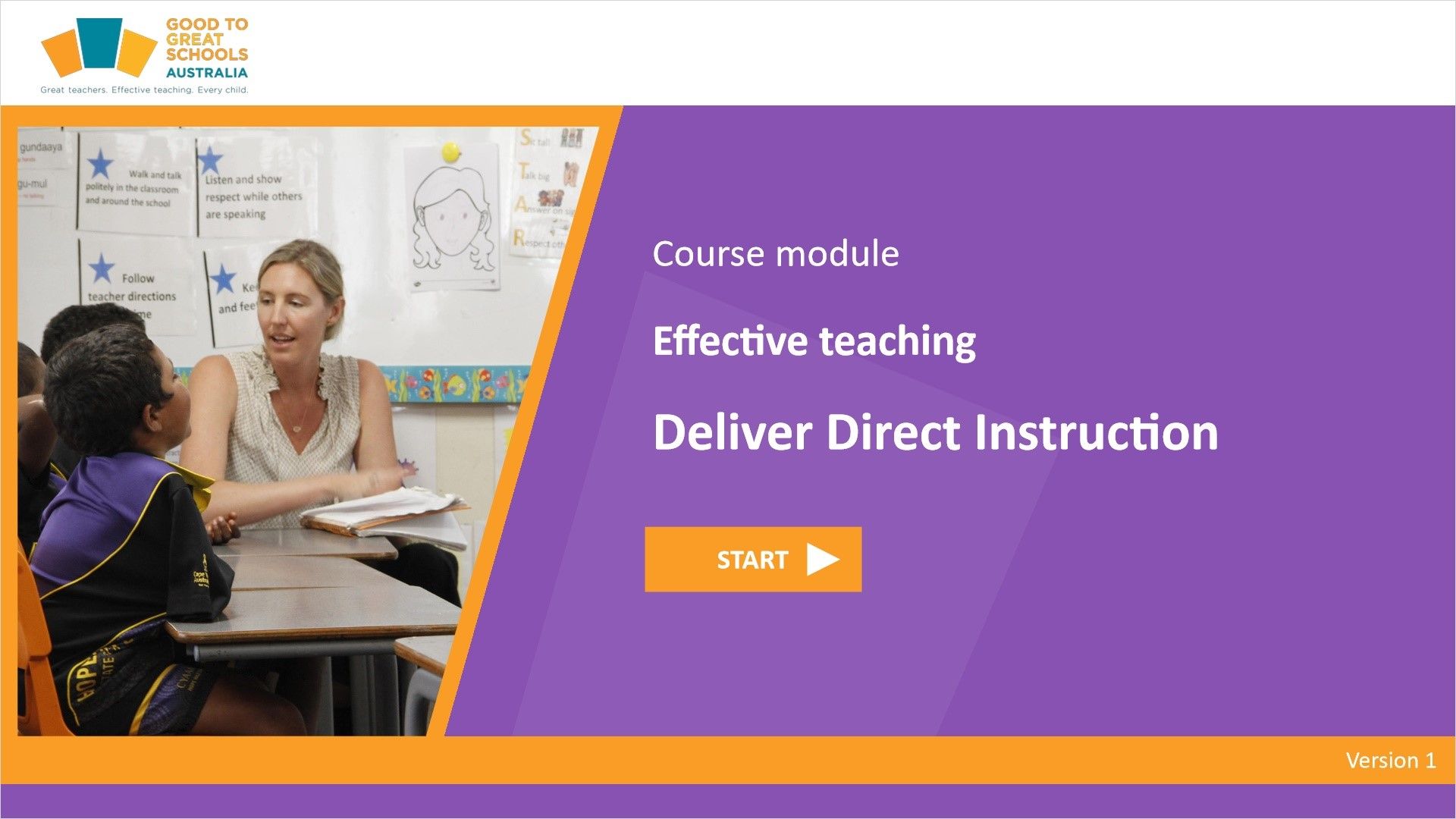Effective Teaching
Deliver Direct Instruction

Program: Effective Teaching
Module: Deliver Direct Instruction
Overview
Teaching Direct Instruction is a professional learning module for teachers and teaching assistants that is aligned to AITSL national standards. Participants will learn how to prepare for teaching by understanding how to set the group up for success and using the Teacher Guide and Teacher Presentation Book. They will also understand student engagement strategies and the importance of building relationships with parents.
Learning intents
- Understand importance of placement test in placing students in programs and levels (3.2.02).
- Understand how to group students and maximise instructional time to manage classroom activities (3.4.02).
- Understand the direct instruction content and the rationale behind program sequencing (3.1.02).
- Implement all parts of direct and explicit instruction lessons (3.2.07).
- Demonstrate techniques that engage students and deliver lesson components to fidelity (3.1.02).
- Understand basic direct instruction techniques and why they are used (3.1.03).
- Understand components of effective teaching resources (such as the Teacher Guide) that align with core programs (3.1.04).
- Understand basic effective teaching techniques and practices in academics and behaviour (3.2.01).
- Demonstrate ability to teach lessons using direct and explicit instruction teaching techniques (3.2.01).
- Plan instructional day around appropriate instructional programs (3.1.10).
- Plan lesson presentation using direct and explicit instruction teaching techniques (3.2.07)
- Implement direct and explicit instruction lessons with fidelity (3.2.08).
- Understand range of verbal and non-verbal communication strategies that support student engagement in small and large group instruction (3.1.05).
- Demonstrate a range of verbal and non-verbal communication strategies to support student engagement in small and large group instruction (3.1.05).
- Plan improvement based on feedback to support student understanding, participation, engagement and achievement during small and whole group instruction (3.1.12).
- Apply classroom practices across all activities by setting clear behavioural expectations and facilitating routines, orderly transitions, and bell to bell teaching (3.4.02).
- Demonstrate direct and explicit instruction concepts in developing independent work that aligns to program being taught (3.1.04).
- Demonstrate remedies and re-testing as indicated in direct instruction following mastery tests and/or student checkouts and use correction procedure when students make errors (3.6.01).
- Understand purpose of providing timely and appropriate feedback to students about their learning and behaviour (3.6.02).
- Demonstrate appropriate corrective feedback and effective teaching procedures for diagnosis and remediation of academic and behavioural errors (corrective actions when correcting errors) (3.6.02).
- Communicate corrective feedback to students during instruction and independent learning (3.6.02).
- Understand how to extract student mastery data from curriculum, assessment, and reporting (3.2.03).
- Plan group instruction based on mastery data and program guidelines (3.2.08).
- Understand how to use mastery test data to assess student learning (3.6.01).
- Demonstrate remedies and re-testing as indicated in direct instruction following mastery tests and/or student checkouts and use correction procedure when students make errors (3.6.01).
- Plan instructional time to implement mastery tests as indicated in the program (3.6.06).
- Implement in-program and out of program assessments to evaluate student mastery levels (3.6.06).
- Review mastery test data to determine individual and group mastery (3.6.06).
- Evaluate next steps for groups, based on mastery test data and in collaboration with the instruction coach (3.6.06).
- Communicate rationale behind program sequencing to school leaders, colleagues and parents (3.1.02).
- Communicate to colleagues and classroom visitors basic direct and explicit instruction techniques and uses (3.1.03).
- Communicate with school leaders, colleagues and parents appropriate use of direct and explicit instruction techniques (3.2.01).
- Communicate any concerns with student mastery by referring to mastery test data (3.6.01).
- Understand how parents can apply practices in the home that maximise their children’s learning opportunities (3.8.01).
- Apply family engagement practices in the community with parents to build relationship between parent and school (3.8.01).
- Demonstrate student learning and positive behaviour to parents through positive postcards, work samples and technology (3.8.01).
- Communicate student progress and home routines for parents to use to improve children’s learning readiness (3.8.01).
- Demonstrate awareness of local Aboriginal and Torres Strait Islander histories, cultures and languages in lessons and discussions with community members (3.8.02).
- Understand how to have honest conversations with parents about student’s needs, behaviour, and their progress (3.8.04).
- Apply honest conversation practices to remind, resolve and reinspire their support (3.8.04).
- Communicate clearly to convey warmth, honesty, and interest in student’s development (3.8.04).
Prerequisite
- Learn Effective Teaching Essentials.
Duration
- 12 lessons
Assessment
Assessment has one stage:
- Test: Knowledge and skills taught in the lessons.
Certification
Participants are eligible for certification based on attendance and completion of assessment requirements for each module.
- Certificate of Attendance: Complete online training and knowledge and skills tests.
